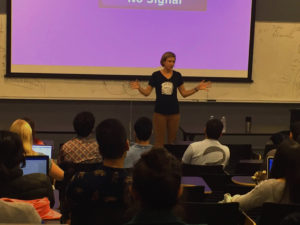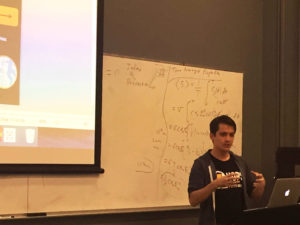Drink Local, Eat Global: Challenging the Food Industry


Are we foodies or have we just become picky? While consumers’ demand for high-quality products have been on the rise over time across a wide range of industries, the food space has become almost second to none to the mounting pressure faced by the entrepreneurs, businessmen, and even chefs that are committed to meet their clients expectations. The truth is innovation is partly responsible for our selectiveness: new technological platforms and the reduced cost supply chain distribution systems have allowed producers all over the country (and the world) to be able to produce the perfect meal or the perfect drink, just in time for us to sit down and enjoy. Scientific advances have also done their fair share in boosting our demands as well, and there have even been advances in molecular chemistry that have given birth to the relatively new field of food engineering.
The resulting increase in the breath of offerings and the ease in which the average consumer can get his or her hands on them has made the food landscape radically change in the last decade. But what are consumers really looking for now whenever they decide what to bring to their table? What about the Americans who are decidedly more concerned about their children’s health, or the increasingly big segment of users that stop to read the back label on a product and question its origins before giving it a space in their kitchen cupboard?
Professor Ricardo San Martin invited to his class two innovators who have been working night and day on these two specific issues. During a period of two hours, Professor San Martin’s students heard from these entrepreneurs who are not only trying to answer the questions we are addressing, but are also trying to make them the centerpiece of their mission to change how Americans stay healthy or develop a more sophisticated palate.
Revolution Foods by Kirsten Tobey

Kristen Tobey from Revolution Foods explaining the challenges of scaling her company nationwide.
The first on stage was Kirsten Tobey, the co-founder of Revolution Foods, a 12 year old initiative that aims to provide healthier and more tasteful meal alternatives for the schools across the United States. For her, what started in a small kitchen wanting to change the way children are fed in Oakland has now become a country-wide phenomenon and agent of change that serves more than 2 million meals on a weekly basis. Kristen talked primarily about four of the biggest challenges she has faced throughout her journey.
The first challenge for her was defining what “healthy” meant. In order to come up with a standardized definition, Kirsten shared that Revolution Foods decided to abide by the National School Lunch Program requirements for what a well-balanced meal would consist of. This benchmark did not only make it easier for them to put together different types of meals with the same nutritional content across the country but allowed them to access all of the schools that would be interested in providing healthier meal options as long as they enjoyed the government reimbursement provided by this government program. She insisted that coming up with a definition that the company could share with both school masters and policy makers was not easy, and reminded the audience that it even took years for tofu to be accepted as a meal replacement. She also shared how they were able to reach a greater scale in the very beginning thanks to an early partnership that they struck with WholeFoods: the conglomerate would endorse their initiative by giving them access to its suppliers at the same cost they filled up their stores nationwide. Kirsten was confident that this support made it possible for them to reach scale by enjoying a conglomerate’s purchasing power when they were still a tiny company. However, with obtaining scale came other inevitable problems, such as the menu differences that needed to go together with the ethnic and cultural diversification across regions in the country. For her, this was evident since they decided to expand from Oakland to San Francisco, where they found a more prevalent Asian community that was used to morning meals being accompanied by rice, not bagels.
“ 80% of the schools that we work with today don’t have a full operational kitchen. Sometimes we even work towards making our kitchen their kitchen, so they are not constrained when serving students.” – Kirsten Tobey
Finally, she wrapped up by making reference to her own personal path. Being a graduate of business school herself, she emphasized that while she had enjoyed her time in the classroom and the courses in her curriculum, the best use she had taken out of her time was from attending after-class meetings with professors and faculty members that helped her and her business partner shape their business model and the idea that ultimately ended up becoming Revolution Foods.
Hopsy by Sebastien Tron

Sebastien Tron from Hopsy emphasizing the importance of local partnerships for the company’s success.
The second speaker was Sebastien Tron, a Haas alum and SCET’s Delta Prize winner that is now committed to redefine the local craft beer industry through Hopsy, an early stages company that just closed its seed capital round a week ago. Sebastien explained how since the very beginning his team wanted to create a system for Bay Area drinkers to enjoy local beer right from the tap without having to go to the bar. Hopsy’s idea was simple: you can sit tight, while our team works on bringing you the best local beer straight from the brewery and into your table. Sebastien elaborated on the importance of being able to manage the growth of your startup at the very early stages. He said that the best decision they could have made was to first try to partner with a few breweries around the corner and then slowly begin to expand. In his own words, “it is easy to be ambitious and radically expand since the beginning, but if you are unable to sustain that growth trajectory for long, investors won’t buy your story and that could later compromise your access to capital.” Another insightful piece of advice Sebastien shared with the public was how his team was no trying to pretend like it was aiming to reinvent every single part of the distribution, supply chain and costumer engagement process. He believes that if someone else has gotten a certain strategy right before, it would not be smart to spend time and resources trying to come up with a way for Hopsy to differentiate itself if it is not compromising the company’s mission.
“When you are small, go straight for the press. It is free publicity, and they’ll showcase you as long as you have an interesting story to tell.” – Sebastien Tron
According to Sebastien, Hopsy’s vision will not only stay with partnering with local beer providers. As this article gets published, the team is working hard on consolidating its relationships with the current breweries to expand their business model to include a “Nespresso for Beer”, an appliance sitting in Bay Area’s kitchens equipped with technology that would let Hopsy know whenever their clients are running out of beer.
